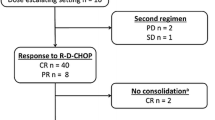Abstract
The aim of the present study was to evaluate an intensive chemotherapy regimen in patients with diffuse large B-cell lymphoma and poor prognosis, as presence of high- or high-intermediate clinical risk, bulky disease, high levels of beta 2 microgloblin, and more than two extranodal sites of involvement at diagnosis.
One hundred previously untreated patients were treated with an intensive CEOP-Bleo regimen with increased doses of cyclophosphamide (1000 mg/m2) and epirubicin (120 mg/m2) in each cycle. Granulocyte colony-stimulating factors was employed to ameliorate severe granulocytopenia.
Complete response was achieved in 79 cases (79%). With a median follow-up of 32.3 mo (range 10–45 mo) only seven patients have relapsed. Thus, actuarial curves at 3 yr, showed that event-free survival was 72%. Five died secondary to tumor progression, actuarial curves at 3-yr for overall survival were 75%. Toxicity was mild, granulocytopenia grade III or IV were observed in the 46% of the cycles; infection-related granulocytopenia was observed in 17%, but no fatality due to therapy was observed. Cardiac toxicity was mild, only seven patients showed a drop in left ejection ventricular function, but no symptomatic heart failure has been observed.
The intensive CEOP-Bleo regimen with increasing doses of cyclophosphamide and epirubicin is a useful and well-tolerated regimen in the treatment of poor prognosis diffuse large B-cell lymphoma.
Similar content being viewed by others
References
The International Non-Hodgkin’s Lymphoma Prognostic Factors Project. A predictive model for aggressive non-Hodgkin’s lymphoma. N Engl J Med 1993; 329:987–994.
Longo DL, et al. Superiority of Pro-MACE-CytaBOM over Pro-MACE-MOPP in the treatment of advanced diffuse aggressive lymphoma. Results of a prospective randomized study. J Clin Oncol 1991; 9:25–38.
Shipp MA, et al. Identification of major prognostic subgroups in patients with large-cell lymphoma treated with m-BACOD and M-BACOD. Ann Intern Med 1986; 104:757–765.
Klimo P, Connors JM. BACOP-B chemotherapy for the treatment of diffuse large-cell lymphoma. Ann Intern Med 1985; 102:596–602.
Gordon LI, et al. Comparison of a second-generation chemotherapeutic program (m-BACOD) with a standard regimen (CHOP) for advanced diffuse non-Hodgkin’s lymphoma. N Engl J Med 1992; 327:1342–1349.
Coiffier B, et al. Intensive chemotherapy in aggressive lymphoma. Updated results of LNH-80 protocol and prognostic factors affecting response and survival. J Clin Oncol 1989; 7:1018–1026.
Fisher RI, et al. Comparison of a standard regimen (CHOP) with three intensive chemotherapy regimens for advanced non-Hodgkin’s lymphoma. N Engl J Med 1993; 328:1002–1006.
Nair R, et al. A randomized comparison of the efficacy and toxicity of epirubicin and doxorubicin in the treatment of patients with non-Hodgkin’s lymphoma. Cancer 1998: 82:2282–2288.
Zuckerman KS, Case DC, Gams RS, Pratschofer E. Chemotherapy of intermediate and high-grade non-Hodgkin’s lymphoma in an intensive epirubicin regimen. Blood 1993; 82:3564–3573.
Avilés A, et al. Adjuvant radiotherapy in the treatment of diffuse large B-cell lymphoma. Leuk Lymphoma, in press.
Cheson BD, et al. Report of an international workshop to standardize response criteria for non-Hodgkin’s lymphoma. J Clin Oncol 1999; 17:1244–1253.
Tilly H, et al. Randomized comparison of ACVBP and m-BACOP in the treatment of patients with low-risk aggressive lymphoma. The LNH87 study. J Clin Oncol 2000; 18:1309–1315.
Lepage E, et al. Prognostic significance of received relative dose intensity in non-Hodgkin’s lymphoma patients. Ann Oncol 1993; 4:651–656.
Bosly A, et al. Outcome is not improved with alternating chemotherapy in aggressive lymphoma. A prospective randomized study for the GELA on 810 patients. Hematol J 2001; 2:279–285.
Shipp MA, Neuberg D, Janicek M, Canellos GP, Shulman LN. High-dose CHOP as initial therapy for patients with poor prognosis aggressive non-Hodgkin’s lymphoma. A dose finding study. J Clin Oncol 1995; 13:2916–2923.
Gianni AM, et al. High-dose chemotherapy with autologous bone marrow transplantation compared to MACOP-B in aggressive non-Hodgkin’s lymphoma. N Engl J Med 1997; 332:1290–1297.
Gordon LI, et al. Phase I trial of dose escalation with growth factors support in patients with previously untreated diffuse aggressive lymphoma. Determination of the maximum tolerated dose of Pro-MACE-CYTABomp. J Clin Oncol 1996; 14:1275–1281.
Meyer RM, Hryniuk WM, Goodyear ME. The role of dose intensity in determining outcome in intermediate-grade non-Hodgkin’s lymphoma. J Clin Oncol 1991; 9:339–347.
Author information
Authors and Affiliations
Corresponding author
Rights and permissions
About this article
Cite this article
Avilés, A., Jesús Nambo, M., Neri, N. et al. Intensive chemotherapy in the treatment of aggressive diffuse large B-cell lymphoma. Med Oncol 21, 269–272 (2004). https://doi.org/10.1385/MO:21:3:269
Received:
Accepted:
Issue Date:
DOI: https://doi.org/10.1385/MO:21:3:269



